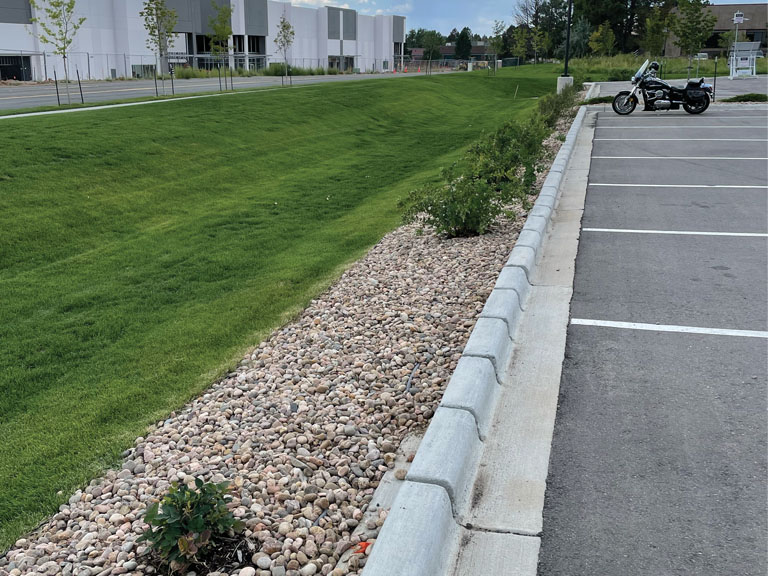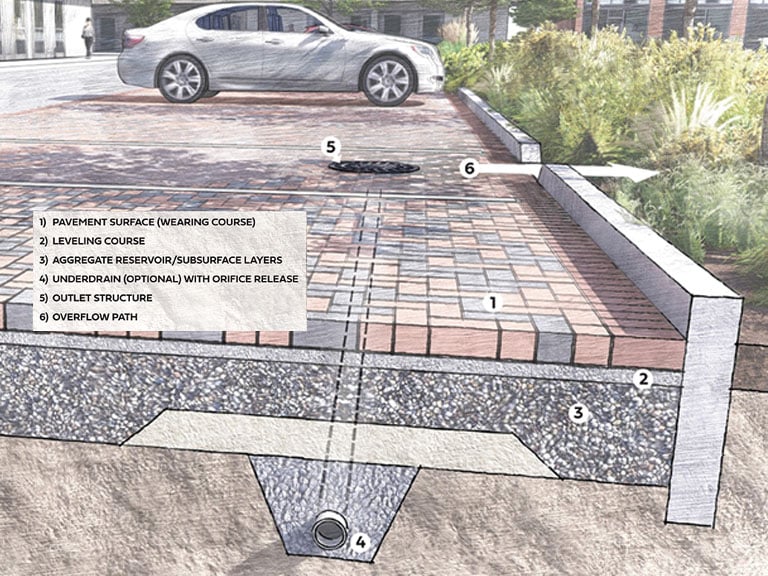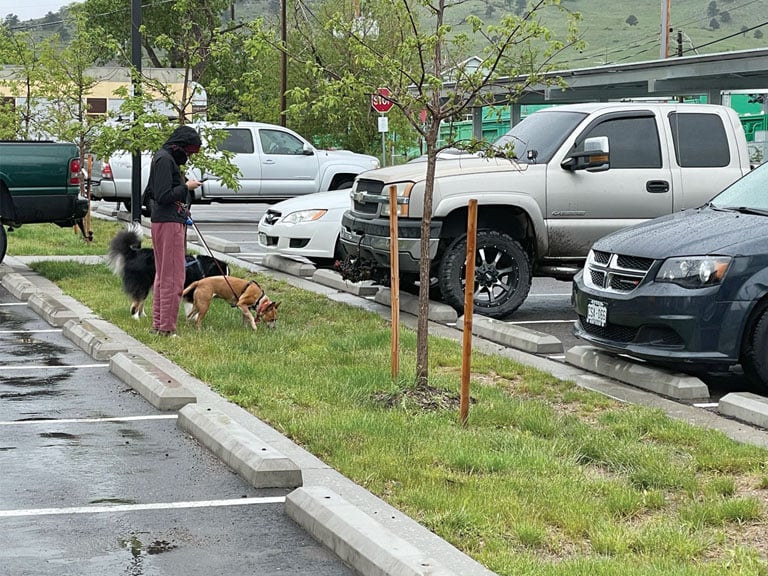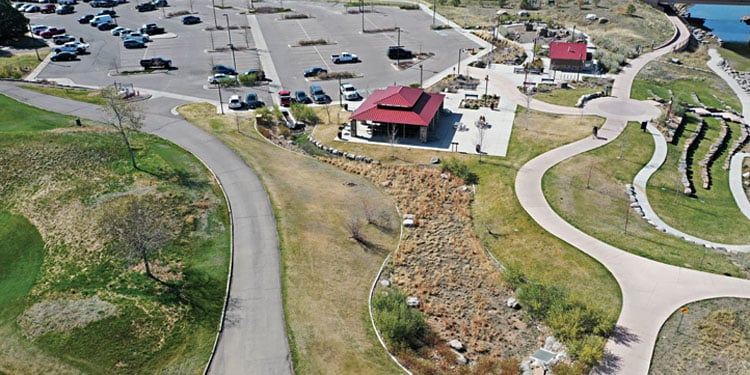Thoughtful parking lot design and maintenance can minimize stormwater runoff impacts and protect local waterways from harmful pollutants.
By Stacy Wilson, Andrew Earles, and Jonathan Jones
Proper stormwater management is an important consideration for parking lots and parking structures, from the stages of planning, design, and permitting, through construction, and during the long-term operation and maintenance of a facility. This is important from the traditional standpoint of drainage as well as related to concerns regarding pollutants transported by the stormwater.
Typically, runoff from parking facilities contains many kinds of pollutants associated with vehicles such as gasoline, diesel fuel, hydraulic fluids, and metals. If these pollutants are not reduced before the runoff leaves the site, they can damage the water body that ultimately receives the runoff. Additionally, replacing a previously vegetated ground surface with a paved surface typically increases the amount of runoff that is generated by a site, and these increased flows can also damage adjoining water bodies.
Fortunately, many cost-effective measures exist to mitigate the potential adverse effects of parking facility runoff before its discharge into the storm drain system and nearby waterways.
Hydrologic effects of impervious areas
Construction of impervious areas such as parking lots alters the hydrologic characteristics of the land. Although most undeveloped (i.e., pervious) land has relatively high potential to infiltrate rainfall, impervious land increases the rate, volume, and frequency of stormwater runoff. For example, small, frequent rainfall events generally produce little to no runoff from pervious areas but will generate runoff from impervious areas. The rates and volumes of this runoff can increase by orders of magnitude for small rainfall events if not managed properly. At a watershed scale, these hydrologic changes can contribute to flooding, channel instability, and degradation of water quality.
Effective management of parking lot runoff begins with management of hydrology, including measures to infiltrate and slow down stormwater runoff. Although parking areas must provide a suitable surface for vehicles, runoff from impervious areas can be drained toward pervious landscaped areas, rather than directly channeled into a storm inlet and the storm drain system.
Pervious landscaped areas provide opportunities for runoff to infiltrate, and vegetation slows runoff velocities. Landscaped areas have the added benefit of helping to mitigate the heat island effects in parking lots. Many parking facilities already incorporate vegetated features, and their strategic use can provide many benefits. Vegetated areas that may be specifically designed to control stormwater runoff include grass buffers, grass swales, and rain gardens, among others. Permeable pavements are another stormwater control measure that is effective at managing hydrologic changes of parking areas through infiltration. All these practices help to mitigate hydrologic changes to the rate, volume, and frequency of stormwater runoff by infiltrating or slowly releasing runoff from parking areas.

of distributed curb cuts. Credit: Wright Water Engineers, Inc.
Water quality characteristics of parking lot runoff
Broad classes of representative pollutants within parking facility runoff include: sediment and particulates, such as from vehicle abrasion and pavement degradation; metals like lead, chromium, and copper from tire wear and catalytic converters; organic compounds like oil and grease, gasoline and diesel fuel, and hydraulic fluids; litter and debris from facility users; nutrients, mainly nitrogen and phosphorus, such as from landscaped areas around the facility; bacteria from birds and other animals; and salts, including chloride and sodium.
These pollutants can adversely affect the ability of nearby waters that receive the runoff to sustain aquatic life like fish and insects, as well as to provide other “beneficial uses” like public water supply, agricultural and industrial water supply, and recreation — ranging from swimming to wading and boating.
Traditional methods for ensuring vehicle safety during cold weather can complicate efforts to reduce pollutants in stormwater runoff. For example, chloride present in road salt is widely found in streams in cold climates and can be detrimental to fish and other aquatic life. Sand used for deicing causes turbidity in streams and can “smother” insects that live on the channel bottom.
The absence of proper mitigation measures during the construction of new parking facilities or the modification of existing facilities can allow sediment from the construction site to wash into streams, harming aquatic life and causing unsightliness and other problems. Similarly, if they are large enough and not managed properly, gasoline and diesel spills and leaks at parking structures can have sudden deleterious effects to nearby waters.
Mitigation options: source controls
Several options exist for mitigating the adverse effects of changed hydrology — increased stormwater runoff frequency, rate, and volume — and diminished water quality. One approach to mitigating the increased volume of stormwater runoff generated by parking lots is to address the source — that is, impervious areas — by rethinking standard parking lot design.
The typical parking lot consists of a large, often mostly unused, impervious area. Alternatively, structured parking, while more expensive, has many benefits, including minimizing the exposure of parking and driving surfaces to stormwater runoff and freeing up land for other uses.
Another option to reduce runoff at the source involves using a permeable pavement system as an alternative to the standard impervious pavement used in most lots. Used for decades in Europe, permeable pavement systems are increasingly being used in the United States. Although permeable pavements may have greater capital costs than conventional pavements, they may allow the owner to maximize parking spaces by avoiding other types of stormwater control measures that take up surface space.
Permeable pavement systems enable stormwater to infiltrate to a layer of aggregate, which acts as a temporary reservoir for stormwater. Depending on the design of the system, collected stormwater may then be slowly released into the storm drain system through an underdrain with an orifice, infiltrated into the subgrade, or handled by means of a combination of the two.
Some municipalities allow the use of permeable pavement systems to help meet water quality permitting requirements. The system’s layers facilitate filtration, its aggregate layer can be sized to accommodate a particular design storm event, and the underdrain orifice provides a controlled release rate.
Types of permeable pavement systems include permeable interlocking concrete pavement, concrete grid pavement, porous gravel pavement, and reinforced grass pavement. Not all permeable pavement systems perform equally or are suitable for all conditions. For example, porous asphalt and pervious concrete are not recommended in some areas due to poor performance and degradation.

Mitigation options: conventional stormwater control measures
As discussed above, designing parking lots with impervious areas that are not directly connected to the storm drain system is important for minimizing the negative effects of increased stormwater runoff and pollutant discharges. Strategically placed stormwater control measures accept runoff from neighboring impervious areas. Depending on the type of control measure used, runoff may then be released to the storm drain system at a controlled rate, be partially or fully infiltrated into the subsurface, or be handled by some combination thereof.
Sedimentation facilities are one type of control measure that captures and temporarily stores runoff before releasing it, at a controlled rate, into the downstream storm drain system. The facility outlet structure is designed to control peak flow rates, so they do not exceed predevelopment peak flow rates across a range of storm events, thereby protecting receiving waters from erosion and hydromodification associated with increased flow rates.
Temporary storage creates an opportunity for suspended sediments and associated pollutants to settle out before runoff is released downstream, improving water quality. However, a “hold and release” sedimentation facility typically does not reduce significantly the overall volume of runoff, and pollutants targeted for treatment are primarily restricted to those associated with sediment. An example of a sedimentation facility is an extended detention basin, which is typically used to treat runoff from larger areas.
Infiltration stormwater control measures partially or fully infiltrate captured runoff and may or may not be vegetated. Overall runoff volume is reduced through infiltration losses, and the design of an infiltration control measure typically includes a layer of filtration media, which provides water quality benefits. Vegetated infiltration facilities include rain gardens — also known as bioretention cells — and vegetated swales or buffers. Vegetation promotes infiltration, provides nutrient uptake, and adds community value.
Partial infiltration facilities include an underdrain to facilitate drainage and reduce surface ponding. An orifice may be added to the underdrain to control the rate of discharge into the storm drain system. Full infiltration facilities, on the other hand, rely on the subsurface to infiltrate the full runoff volume. Not all soils are suitable for full infiltration stormwater control measures.

Manufactured treatment devices
Manufactured treatment devices use proprietary technologies to remove pollutants from stormwater runoff, often through either sedimentation or filtration. Sedimentation treatment devices, such as hydrodynamic separators, use processes that encourage sedimentation to remove larger particles, trash, and debris. Filtration treatment devices include layers of filtration media designed to remove smaller particles and dissolved pollutants, with options to include media designed to target specific pollutants.
The high filtration rates of some manufactured treatment devices may enable the use of a smaller footprint than that required by conventional full or partial infiltration stormwater control measures. Consequently, manufactured treatment devices may be a good option for space-constrained and highly urbanized environments.
Maintenance procedures, access, and frequency vary among manufactured treatment devices and site conditions and should be carefully evaluated during the device selection process. It is important to note that, in general, manufactured treatment devices neither detain nor reduce runoff, and application of these devices may be most appropriate as a first step in a “treatment train,” or series of stormwater control measures, that includes one or more of the conventional measures discussed above.
Sound strategy
The changed hydrology and unique pollutants associated with parking lots necessitate the planning and implementation of effective stormwater management as a component of parking lot design, construction, and maintenance. Local municipalities and state health departments often provide guidance for implementation of source control and treatment options that meet the standards specific to a city or state.
An effective stormwater management strategy for parking facilities is not just a regulatory necessity — it’s an investment in sustainability, environmental protection, and long-term operational efficiency. By incorporating thoughtful design elements such as permeable pavements, vegetated swales, infiltration systems, and other stormwater control measures, parking operators can significantly reduce runoff impacts while enhancing the functionality and aesthetics of their facilities. As municipalities continue to refine stormwater regulations, forward-thinking parking facility owners and managers who proactively integrate best practices will be well-positioned to meet compliance requirements, protect local waterways, and contribute to more resilient urban environments.
STACY WILSON is a water resources engineer for Wright Water Engineers, Inc. She may be reached at swilson@wrightwater.com.
ANDREW EARLES is vice president of water resources for Wright Water Engineers. He may be reached at aearles@wrightwater.com.
JONATHAN JONES is the chief executive officer of Wright Water Engineers. He may be reached at jonjones@wrightwater.com.














